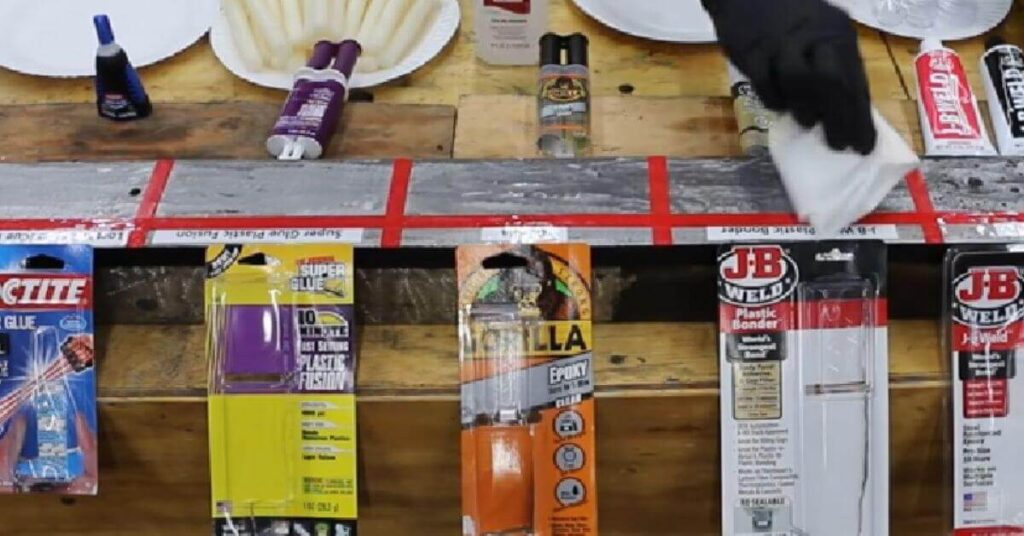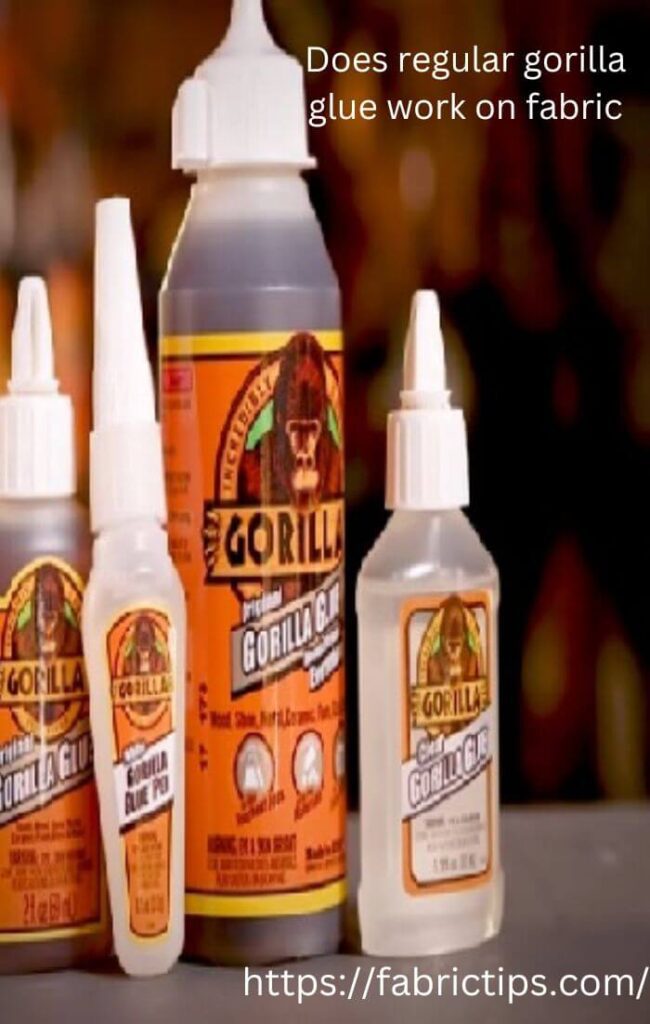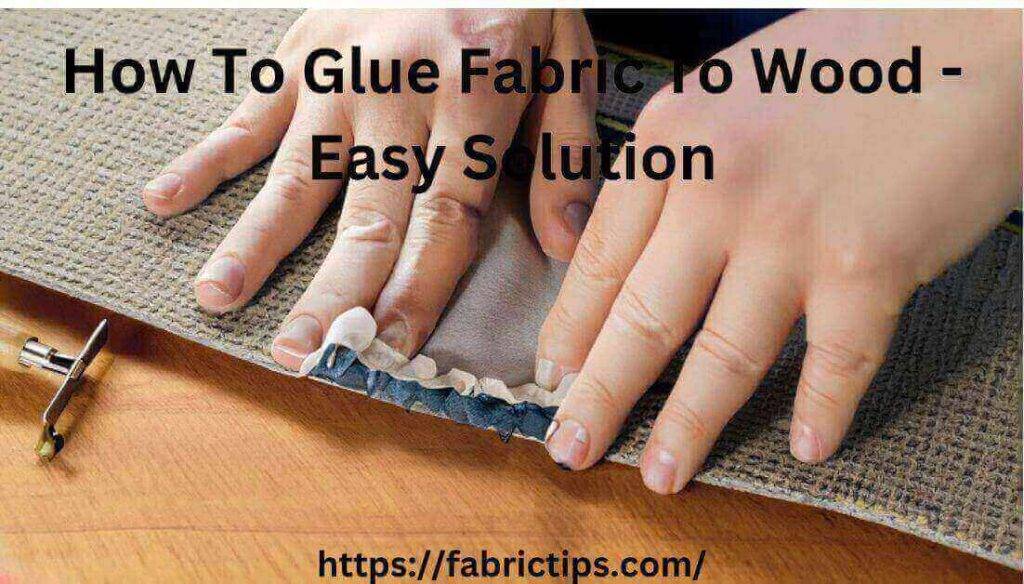Last Updated on December 13, 2025 by Wahid
Original Gorilla Glue built a reputation for its strength, industrial holding power, & versatility. With its unique water-activated polyurethane formula, Gorilla Glue forms a strong bond with virtually anything, making it your solution for almost any repair or project.
Are you worried about “Does Original Gorilla Glue Work On Plastic?” Yes, it works on some plastics, but others do not. Generally, HDPE (high density polyethylene) works as long as its surface is textured. Conversely, silicone, while technically not a polymerized plastic, doesn’t work.
Gorilla glue doesn’t bond to most polymers like wood, cardboard, leather, etc. In contrast, most polymers (plastics) are chemically ‘closed’ to Gorilla glue, requiring mechanical rough-surface bonding instead of chemical bonds. Unfortunately, Gorilla Glue original is not suitable for rubber, polypropylene, or polyethylene.
Depending on the type of plastic, Gorilla Glue is suitable for use as an adhesive. The company also manufactures specialized glues for plastics, super glue, & the original Gorilla Glue brand. Well, let’s see more deeply about various Gorilla Glue and original Gorilla Glue below.
Can You Use Gorilla Glue On Plastic?
A DIYer has carpenter’s glue for bonding wood, epoxy for metal-to-metal repairs, super glue, and silicone for repairing glass, yet what about plastic? You probably have some Gorilla Glue on hand. But does original gorilla glue work on plastic?
[amazon box=”B014OVHAOY” description=”None”]
Basically, Gorilla Glue doesn’t work well on plastic or vinyl-type materials. It forms chemical bonds by using moisture, expanding between both surfaces. Glue can’t bind plastic to other surfaces since plastic is not permeable.
Here’s what Gorilla Glue works for plastic surfaces & projects, and what you shouldn’t use.
- The Gorilla Glue range of adhesives is designed for a wide variety of surfaces and tasks. However, we all have at least one bottle of original glue in the house.
- Temperature-resistant and 100% waterproof, this glue resists water and ice. With water, you activate the polyurethane formula.
- The manufacturers claim that it works on ‘virtually anything,’ so it must work well on plastic. However, some caveats exist.
- Can you use gorilla glue on rubber? Original Gorilla Glue isn’t very effective for attaching plastics or rubber items with high rubber and oil content.
- Also, soft plastics are definitely not recommended.
- Generally, Gorilla Glue cannot penetrate plastic surfaces and form chemical bonds. Plastics won’t stick together because the adhesive isn’t strong enough.
- In addition, it should not be used on polyethylene or polypropylene plastics.
However, would you like to know what they are? Yes, you can find more information by scrolling down below.
The Original Gorilla Glue Sticks To Plastics, Doesn’t It?
[amazon box=”B0000223UV” description=”None”]
Due to its water-activated adhesive, Gorilla Glue sticks to some plastics nicely but not to others. Because of this, Gorilla Glue does not bond well with plastics that cannot absorb liquids. In spite of the company’s expansion of its glue line, most of them don’t adhere well to most plastics.
- As a polyurethane glue, Gorilla Micro Precise Super Glue is rapid-curing. “Cyanoacrylate” is its technical name.
- A cyanoacrylate adhesive is solvent-free, cures rapidly, and contains only one adhesive compound.
- Generally, Glues in two-component syringes have a binder in one & a hardener in another, so they are called 2-component adhesives.
- Gorilla Glue dries in “10 to 45” seconds, but these sorts of adhesives have various uses.
- In cyanoacrylate adhesives, such as Gorilla Glue, cure time is so quick.
Although they were discovered in the 1950s, manufacturers struggled for nearly 2 decades to make them available in liquid form. According to the manufacturers, Gorilla Glue bonds to practically anything. Even so, there is an exception, so the company now offers adhesives bonded to “cyanoacrylates.”
Materials that Gorilla Glue cannot bond to without special ingredients include:
- For “Porous substrates” as wood & leather, you should use polyurethane glues which contain accelerators.
- Then, Pretreatment is required for polyolefin plastics.
- Neither Teflon nor any adhesive can stick to Teflon since they change its chemical formula, so the adhesive cannot adhere to “Teflon.”
- As the glue expands, it creates a strong bond with the materials. Nevertheless, anything it bonds to is weak since it cannot expand into plastic.
- According to this new formulation, Gorilla Glue adheres to “metal, ceramics, stone, and rubber, yet not plastic.”
In most plastics, Gorilla Glue won’t stick well because the cyanoacrylate builds a chemical connection with the water ions. Except for most plastics, almost every surface has some level of moisture because of humidity. Moisture is necessary for the cyanoacrylates to bond together.
Let’s check out which plastics the original formula works with & which demand specialized adhesives.
Which Gorilla Glue Is Suitable For Plastic?

Now, the “Original Gorilla Glue” is supposed to be suitable for all plastics, except “Polyethylene” & “Polypropylene.” However, if you don’t know which plastic is involved, you can’t tell whether a particular formula will work.
Therefore, what is polyethylene & polypropylene plastic? Most plastics are made of polyethylene, which comes in 3 varieties:
- Polyethylene Terephthalate: PETE and PET plastic are used to make food & liquid containers, clothing fibers, and engineering resins containing glass fibers.
- High-Density Polyethylene: HDPE, a petroleum-based plastic, is used for making plastic bottles, plastic lumber, and piping.
- Low-Density Polyethylene: LDPE is used for manufacturing containers, tubing, bottles, & laboratory equipment. Additionally, LDPE is a common material for plastic bags.
Polypropylene (PP) is widely used for packaging and labeling. Despite its rugged appearance, this plastic is highly resistant to chemical attack.
Polyvinyl Chloride (PVC) constitutes yet another form of plastic. In addition to solid PVC pipes, bottles & non food packaging are made from it. Due to its use in credit cards, it is probably present in your own wallet.
However, if you use Gorilla Glue, you’ll mostly work with polypropylene or polyethylene. Most of the product’s state that they will not work with those plastics.
Does regular gorilla glue work on fabric? The performance of each glue on plastic is outlined below.
Gorilla Glue Original Formula: Let’s Find Out
Original Gorilla Glue meets a variety of DIYer & homeowner needs. It forms a secure bond instantly, takes only an hour to clamp, & is water-resistant. Because the original formulation has a tan shade, the manufacturer offers “Gorilla White & Clear” formulations.
[amazon box=”B09WB2VC2S” description=”None”]
Gorilla Original Gorilla Glue, Waterproof Polyurethane Glue, 8 Ounce Bottle
As stated by the Gorilla manufacturer: “Gorilla Glue is suitable for a wide range of plastics. However, it should not be used on polyethylene (PE) and polypropylene (PP) plastics or all rubber products with a high oil & plasticizer content as well.”
Gorilla Super Glue
Gorilla Super Glue forms tight seals without clamping or moisturizing like Gorilla Glue. Unfortunately, plastics still do not adhere well to it.
Gorilla Super Glue, 20 Grams, Clear, (Pack of 1)
In the opinion of the producer, Gorilla Super Glue is “unsuitable for use with polyethylene and polypropylene plastic and other similar materials also.”
Gorilla Epoxy
The epoxy is 2-part, which means it comes in a double syringe. Unlike other Gorilla Glue, this one mentions the kind of plastic it will work with. Many plywood sheets are decorated with PVC sheets. Also from the company, “Gorilla Weld” is a 2-part adhesive that adheres poorly to plastics.
Gorilla 2 Part Epoxy, 5 Minute Set, .85 Ounce Syringe, Clear, (Pack of 2)
According to the manufacturer, “Gorilla Epoxy adheres well to PVC sheets.” However, it should not be used on PVC pipes or plastics with low surface energies, for example, polypropylene (PP) and polyethylene (PE), or rubber with a high oil and plasticizer content.”
Does Gorilla Glue Bond Plastic To Plastic?

Gorilla Glue offers a variety of adhesive products. Gorilla Glue’s suitability as a glue for bonding plastic to plastic depends on the particular type you use. If you want to know what materials Gorilla Glue can bond to, check the product label & manufacturer’s instructions.
The Gorilla Glue Company offers several adhesive products, which include:
Gorilla Glue Original: A polyurethane-based adhesive that bonds strongly to various surfaces, including plastics. The bonding of plastic to plastic is possible in many situations.
[amazon box=”B00006LAAQ” description=”None”]
Gorilla Super Glue: A cyanoacrylate-based adhesive that bonds quickly and strongly. Certain plastics can be bonded with this method, although the compatibility varies with the type of plastic.
[amazon box=”B082XGL21J” description=”None”]
Gorilla Epoxy: This epoxy adhesive is two-part and can bond a variety of materials, including plastic. In most cases, it provides a durable and strong bond.
[amazon box=”B08V4DXTRZ” description=”None”]
Gorilla Clear Grip: This adhesive is clear and non-foaming, so it bonds plastic, as well as other materials. Clear bonds are ideal for applications that require a strong bond.
[amazon box=”B06X6JPZW1″ description=”None”]
Gorilla Construction Adhesive: Suitable for various construction materials, and it may also bond to certain types of plastic.
[amazon box=”B0B7BRDRPG” description=”None”]
Gorilla Glue On Plastic: How To Use It?

If you can’t find another glue handy, find out how to use plastic glue. You won’t get the same hold as another bonding agent, but it is at least temporary.
For Gorilla Glue to work on plastic, it is necessary to use water and a damp rag to clean it. Additionally, you need an effective clamping system. The use of gloves is also recommended for those who have sensitive skin. After cleaning and preparing the surface, you’ll need to apply the glue & clamp together the parts.
Gorilla Glue must be applied to plastic in the following manner:
- Prepare the desired surfaces. In most cases, the surface must be dust-free, but the glue will need a surface to expand on. Sand the surface until it is rough with sandpaper, then clean it with a soft cloth.
- Wet 1 side of the surface with a damp cloth without soaking it.
- You should dispense Gorilla Glue carefully onto the surface after it has dried.
- Make sure the surfaces are clamped tightly and evenly. It depends on what you are gluing, rather than using a clamp, you may need some heavy objects. In order to keep small items together, tape or rubber bands can be used.
- With a dry cloth, wipe off the wet glue which has fallen out. Remove dried glue with sandpaper, chisels, or scrapers.
[amazon box=”B000RG2Y56″ description=”None”]
How Long Does Gorilla Glue Hold On Plastic?

You almost certainly have Gorilla Glue on hand. But does original gorilla glue work on plastic? How long does Gorilla Glue hold on plastic? Generally, it depends on several key factors. Well, let’s see those reasons below.
- The process you followed before bonding the surfaces.
- Your patience in allowing them to be cured.
- In addition, the kind of weather and forces experienced in the joint will influence its lasting time.
- Strong shear forces or hard blows will not be able to break a Gorilla Glue bond. Its water-resistant bond is not waterproof, thus constant dampness may weaken the bond.
- However, people have reported five-year-old plastic items that still hold up after being repaired with Gorilla Glue.
- Water is needed for Gorilla Glue to set, so you dampen the surface that is connecting the two surfaces before joining them.
- When you do not do this, your adhesive will not set properly if no moisture is present in the air. There will be a weak join that will not hold.
- In contrast, air moisture can make Gorilla Glue set inside the bottle and render it useless. After using it, make sure to tightly cap it.
FAQs
How Long Does Gorilla Glue Take to Dry on Plastic?
You must wait before the glue will set and harden once you have applied Gorilla Glue to the plastic pieces. In order for Gorilla Glue to cure completely on plastic, it needs to dry & cure for at least 24 hours. However, once the glue clamps and sticks to the plastic, it takes about 1-2 hours.
How Do I Get Gorilla Glue Off My Hands?
Don’t try simply pulling Gorilla Glue off your hands; you need to be patient. Instead, soak the glue-bonded area with soapy warm water, then rub gently until the sticky substance comes off.
Acetone can be used to remove glue if you have it on hand. Also, a fingernail polish removal solution will work. Be sure to follow the label instructions provided by the manufacturer.Does Gorilla Glue Work on Plastic Dishes?
The Gorilla Glue should not be applied to any food-contact items. When swallowed, consult poison control immediately. There is information on first aid available on the website of Gorilla Tough. Also, do not apply it to plastic toys once the glue has set. Toys can’t always resist children’s urges to chew and suck.
[amazon box=”B0BLY1P9RV” description=”None”]Does Gorilla Glue Work on Plastic?
4 plastics cannot be bonded with Gorilla Glue because of their surface tension properties. Does original gorilla glue work on plastic? No matter how rough the surface is, it won’t bond.
** DERLIN
** PP (POLYPROPYLENE)
** TEFLON
** UHMW HDPE (ULTRA HIGH MOLECULAR WEIGHT HIGH DENSITY POLYETHYLENE)
Yes, with Gorilla glue, you can bond any plastic, however, the tensile strength will be low. This adhesive is good for holding small parts and small areas, but not for mechanical bonds.Would Gorilla Glue Clear Work on Plastic Models?
The choice is poor. CA (super) glue has a stronger and faster bond than this glue, although it does not bond plastic together as effectively as plastic cement (also known as plastic glue or styrene cement). A good glue is plastic cement, which is also cheap. When Gorilla glue cures, it expands. Minis shouldn’t be stuck with expanding glue.
Which Glue Bonds To Polypropylene?
Generally, it depends on the thickness of the plastic, such as sheet plastic or tubing. Normally, sheet varieties are bonded with heat. Glued tubing is specially made for this use with a solvent-based adhesive. In most cases, it consists of 3 items: a cleaner, a prepping solution, & a solvent glue. The same glue is used to glue PVC pipe, but the solvent might differ.
It is extremely dangerous to inhale solvent-based glues. Don’t let anything get into your eyes. The stuff isn’t great for your skin either; you should wear gloves, although it’s fairly easy to wipe off.Is Gorilla Glue Safe for Plastic?
t is safe to use Gorilla Super Glue on plastic, although permanent bonds are unlikely. According to the plastic, some fixes will last longer compared to others. You can usually use it instead of Gorilla Glue to glue plastic.
However, Super Glue or Gorilla Glue should be used with plastic disposable gloves, since it can stick to your skin and become difficult to remove.
Never ingest glue, even Gorilla Glue or Super Glue, and keep it away from your eyes and mouth. Ensure your repairs are done in a well-ventilated area since Gorilla Glue fumes can be toxic.Does Gorilla Glue Damage Plastic?
“Gorilla Glue” doesn’t penetrate and change plastic’s chemical composition. Thus, plastic won’t be damaged and it’s safe to use. Sadly, the bond won’t be permanent, so most plastics should be repaired using epoxy instead.
For a more permanent bond, roughen the plastic surface with sandpaper before applying glue to give it a porous surface. This will mark the plastic surface. There may be a need to sand or chisel off the dried glue, which can damage the plastic.
Bottom Line
Hopefully, you have got your answer about does original gorilla glue work on plastic or not. Actually, Gorilla Glue does not work well on most plastics because the adhesive needs to expand and sink into the material to work well. Prior to applying Gorilla Glue, you must first sand the plastic surface to ensure that the glue adheres to it. However, you can’t expect a strong bond.


